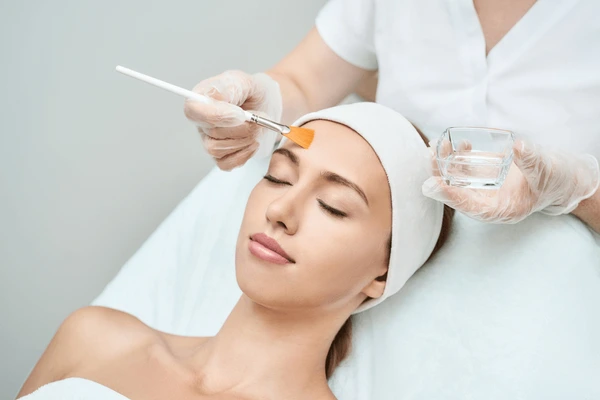Struggling with uneven skin tone or acne scars? We understand how frustrating that can be. At our clinic, we offer the best chemical peel treatments in Bangalore to rejuvenate your skin. Wondering about the chemical peel treatment cost in Bangalore? We provide affordable and effective options to help you achieve smoother, brighter skin. With years of experience and a team of experts, we guide you through every step of your skincare journey. Ready for a glow-up? Book your appointment today and experience the best chemical peel treatment at competitive costs in Bangalore!
What Is Chemical Peel Treatment?
Chemical peel treatment is a skincare procedure that uses a chemical solution to exfoliate and rejuvenate the skin. It works by removing the top layers of dead skin cells, revealing smoother, fresher skin underneath.
- Types of chemical peels:
- Light Peel
- Medium Peel
- Deep Peel
The best age for this treatment is 25-50, suitable for both men and women. The procedure typically takes 30-60 minutes. In Bangalore, it boasts a high success rate in improving skin texture and tone. Ready to refresh your skin? Let’s get started!
Chemical Peel Cost in Bangalore
The cost of a chemical peel treatment in Bangalore typically ranges between ₹3,000 and ₹15,000 per session. The final price depends on various factors such as:
- Type of peel (Light, Medium, Deep)
- Skin condition and concerns
- Clinic’s location and expertise
- Number of sessions required
- Additional services or products used
| Treatment Type | Cost (INR) |
| Light Peel | ₹3,000 – ₹5,000 |
| Medium Peel | ₹6,000 – ₹10,000 |
| Deep Peel | ₹12,000 – ₹15,000 |
Insurance coverage for chemical peels is generally not included, as it is considered a cosmetic treatment. However, some clinics offer payment plans or packages to make it more affordable. Ready to book your session? Let’s discuss the best options for you!
What are the different types of chemical peels?
Chemical peels are classified into three types: superficial, medium, and deep, based on how deeply they penetrate the skin layers. Superficial chemical peels, which are the most commonly used at our clinic in Bangalore, target only the outermost layer of the skin. These peels are effective for improving acne, texture, and providing a glowing appearance, and are considered very safe.
Medium peels, such as TCA and Phenol peels, are more intense and should only be performed under the guidance of an experienced dermatologist. When applied correctly, they can effectively treat melasma, pigmentation issues, and acne scars. However, improper application can lead to skin damage.
Deep peels are typically not recommended for individuals with brown skin, as they carry a higher risk of causing severe pigmentation issues.
Benefits of Chemical Peel Treatment
Chemical peels offer long-lasting skin benefits, though maintaining results requires proper skincare. While the results are not permanent, regular treatments can help keep your skin looking fresh and youthful.
- Reduces acne scars and blemishes
- Evens out skin tone and texture
- Minimizes fine lines and wrinkles
- Boosts collagen production for firmness
- Improves skin clarity and brightness
- Minimizes sun damage and pigmentation
- Enhances absorption of skincare products
Ready to reveal your glowing skin? Let’s start your transformation!
How Does Chemical Peel Work?
Chemical peels are an effective way to enhance skin texture and appearance. Ideal candidates include both men and women between 25-50, especially those dealing with acne, hyperpigmentation, or fine lines. People with active skin infections or sensitive skin may not be suitable.
The treatment works by applying a chemical solution to exfoliate the outer layers of skin, which stimulates skin renewal. This process leaves your skin smoother, brighter, and more youthful-looking.
Procedure:
- Cleanse the skin thoroughly
- Apply chemical solution to targeted areas
- Let it sit for a set time
- Rinse off and neutralize solution
- Apply soothing serum or moisturizer
Results usually appear within 7-10 days as the skin heals. Chemical peels can be combined with treatments like facials, microneedling, or Botox for enhanced results. Ready to rejuvenate your skin? Book your consultation!
What Happens in Chemical Peel Treatment?
Chemical peel treatments involve a few simple steps to refresh and rejuvenate your skin. Here’s what you can expect before, during, and after the procedure.
Before Treatment
- A thorough consultation with the expert
- Skin cleansing and preparation
- Possible application of numbing cream (for deeper peels)
- Discuss any medical history or concerns
- Avoid sun exposure and heavy skin products
During Treatment
- A chemical solution is applied to the skin
- A tingling or mild burning sensation may occur
- Solution stays on for a specific time
- Skin will begin to peel gently
- A soothing mask or moisturizer applied afterward
After Treatment
- Redness or irritation may occur initially
- Skin will start to peel within a few days
- Avoid direct sun exposure and makeup
- Follow aftercare instructions for best results
- Moisturize regularly to promote healing
Restrictions:
Avoid strenuous activities for 48 hours after treatment.
Anesthesia: Numbing creams are applied for comfort, no full anesthesia needed.
Post-Treatment Activities: You can resume most activities after 24-48 hours, but avoid sun exposure for at least a week.
Side Effects of Chemical Peel and Recovery Time
Chemical peels are generally safe, but like any cosmetic treatment, they come with a few potential side effects. These may include redness, peeling, or slight irritation during the recovery process.
Recovery Timeline:
- Day 1-3: Redness and slight burning sensation; skin begins to feel tight
- Day 4-7: Peeling starts; mild flaking occurs
- Day 7-10: Skin may appear dry and flaky but starts to smooth out
- After 1-2 weeks: Fresh, glowing skin appears, and results are noticeable
Results can last 3-6 months, depending on your skin type and how well you maintain aftercare. For optimal results, repeated treatments are often recommended.
Side Effects and Risks:
- Temporary redness, swelling, and peeling
- Dry or irritated skin post-treatment
- Increased sensitivity to the sun
- Rarely, pigmentation changes or scarring
Chemical peels can cause an allergic reaction in sensitive individuals, so a patch test is always recommended before proceeding. If you have any concerns, it’s best to consult with our specialists to ensure it’s the right treatment for you.
Limelush Clinic Offers More Under Chemical Peel Treatment
At Limelush Clinic, our chemical peel treatment stands out with its personalized approach and a variety of peel types tailored to your skin’s needs. This treatment is not limited to the face; it can be used on areas like the hands, back, and décolletage.
| Area | Suitable for Treatment |
| Face | Yes |
| Hands | Yes |
| Back | Yes |
| Décolletage | Yes |
Chemical peels are ideal for acne scars, pigmentation, and fine lines. These treatments have been effectively used for over 30 years to improve skin texture and tone. Let’s help you achieve smooth, glowing skin!
FAQs
How are Chemical Peels Useful and How Do They Work?
To understand how chemical peel treatments work, let’s first explore the basics of skin biology. Skin consists of two layers: the epidermis (the outer layer) and the dermis (the deeper layer). The epidermis constantly renews itself, shedding old skin cells every 28 to 30 days. As we age, this process slows down, leading to dull, dry skin and pigmentation spots, which are early signs of aging.
Chemical peels exfoliate the upper layers of the epidermis, stimulating the skin’s natural renewal process and restoring its glow. They also help with acne and clogged pores, as certain peels, like salicylic acid, dissolve oils in the pores, improving acne and skin texture.
Are Chemical Peels Safe?
Yes, chemical peels are safe when performed by a skilled dermatologist. Historically, Cleopatra used lactic acid from sour milk for smoother skin, and today, peels use active ingredients like glycolic acid from sugarcane, mandelic acid from apples, and salicylic acid from willow bark. These are carefully extracted and synthesized to ensure clinical efficacy.
Peels are customized based on skin type, condition, and desired results. A patch test is recommended for sensitive skin to ensure no adverse reactions.
What Precautions Should Be Taken Before a Chemical Peel?
Before undergoing a chemical peel, consult with a dermatologist to discuss your skin goals and treatment plan. Skin preparation is important, so use gentle cleansers, moisturizers, and sunscreens for at least 2 weeks prior. Avoid bleaching, waxing, or scrubbing the skin a week before the treatment.
What to Expect After a Chemical Peel?
Immediately after a chemical peel, you might experience mild redness and itching. Depending on the peel’s depth, you may experience peeling or dryness for 1 to 7 days, followed by rejuvenated skin. If you notice any darkening or lightening of the skin, inform your dermatologist.
Are There Special Post-Treatment Precautions?
After a chemical peel, avoid using harsh face washes or toners. Use water or thermal water sprays to cool the skin, and apply moisturizers with hyaluronic acid. Stay out of the sun and apply sunscreen. Avoid picking at dry skin as it peels.
How Often Should Chemical Peels Be Repeated?
Superficial peels are typically repeated every 2 weeks, medium peels every month, and deep peels once a year. For best results, multiple sessions are often needed, depending on the skin’s condition.
How Long Does It Take to See Results?
Some improvement can be seen after the first session, but optimal results generally require 3 to 4 sessions. Regular treatments will lead to smoother, clearer skin.
What is the Best Chemical Peel for Pigmentation and Acne?
For pigmentation, glycolic acid, TCA peels, and Cosmelan peels are effective. Salicylic acid and Retinol peels work best for acne, while a combination of glycolic and retinol peels, or TCA CROSS peels, are excellent for treating acne scars.
How Long Will a Chemical Peel Last?
The effects of a light peel typically last 1 to 2 months, while medium peels last about 6 months. Deep peels can have long-lasting effects, with proper aftercare.
Is a Chemical Peel Painful?
Chemical peels are generally not painful. You may feel a slight burning or tingling sensation during the treatment, but a topical numbing agent can help alleviate any discomfort.

